Note: As of July 24, 2018, Google AdWords is now called Google Ads
Despite what some people believe, Google has said many times that SEO is not pay-to-play: advertising with Google AdWords will not improve your organic search rankings. At least, not directly. But there are ways you can use AdWords to help improve your SEO strategy.
For example, you can use your PPC data to quickly get insights that will carry over to organic search, saving yourself tons of time and money in the process.
An AdWords campaign can be set up, activated, and driving traffic at scale in a single afternoon, while SEO can take up to 12 months to start seeing strong results. At a cost of around $2,000 per month, you’re looking at a potential investment of $24,000 before you’ll really know whether your SEO strategy is working as planned.
The problem is, what if you spend all that money and time ranking for keywords that don’t end up bringing you much traffic…or that do bring traffic, but no sales?
Using AdWords data to kick off a new SEO strategy is a fantastic way to minimize risk by creating proof-of-concept and testing ideas. You can also mine your PPC data to refine an existing SEO strategy or run ads to reinforce and strengthen your organic search results.
We’ll look at all three possibilities in this article. By the end, you’ll have six different ways to use AdWords to help fuel your organic growth.
Why Use AdWords Data?
When companies look to put together their SEO strategy, they often start with industry tools that identify keyword targeting opportunities, including Ahrefs, SEMrush and Moz.
If you’re following general SEO advice, you’re likely to be searching for keywords with:
- High search volume
- Low competition
…and creating content around your findings to engage those searchers. Since those keywords are easy to target and commonly searched for, you’re likely to find success, right?
Not necessarily.
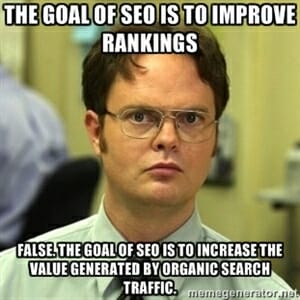 (Source)
(Source)
Although those tools can help you figure out how to drive traffic from search engines, traffic alone isn’t very useful for most of us – unless it leads to conversions.
That’s where AdWords data shines.
Use data from your PPC campaigns to analyze which terms drive the most conversions. From email sign-ups to purchases, you’ll unlock an SEO strategy that can deliver a high return on your investment. Share on XAnd since 50% of marketers say their biggest content marketing challenge is a lack of time, saving some of it is never a bad thing:
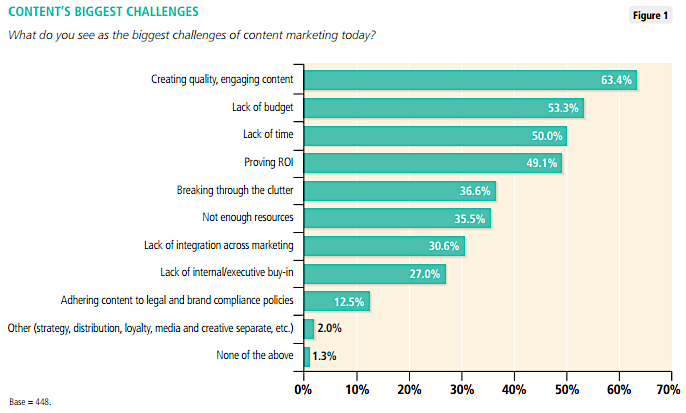
What if…
- you could know for sure which keywords to target with your SEO efforts, rather than wasting time on guess-and-check?
- you knew exactly what to write in your title tags and meta descriptions to blow your competition out of the water?
- you could squeeze far more value out of each of your organic search visitors, even the ones who don’t convert right away?
Read on for six ways you can use AdWords features and data to supercharge your organic search growth.
Further Reading:
- 8 Tips to Improve AdWords Housekeeping and Maximize Success
- How to Take Your AdWords Campaign to the Next Level
- The 10 Most Powerful SEO Tactics for 2018
How to Use Google AdWords to Fuel Organic Growth
1) Accelerate Your Results With Remarketing
Remarketing (aka retargeting) is the process of showing targeted ads to people who have previously visited your site or otherwise engaged with your brand. It’s an extraordinarily powerful tool to go after the 96-98% of people who come to your site but don’t make a purchase. Because those visitors already know your brand, they’re more likely to convert than a random stranger on the Internet.
Remarketing can help improve your SEO results in two very different ways:
A) Learn more about your potential customers by analyzing your remarketing list. Factors like their affinities (long-term interests) and their “in-market audience” categorizations (what they are actively shopping for) can help you refine the types of content and keywords you should be using in your SEO strategy.
To find out this information and more, click the “wrench” menu at the top right of your AdWords account, then go to “Shared library” > “Audience manager”. Then on the left, click “Audience insights”. From there, you can pull up juicy details on the remarketing audience of your choice:
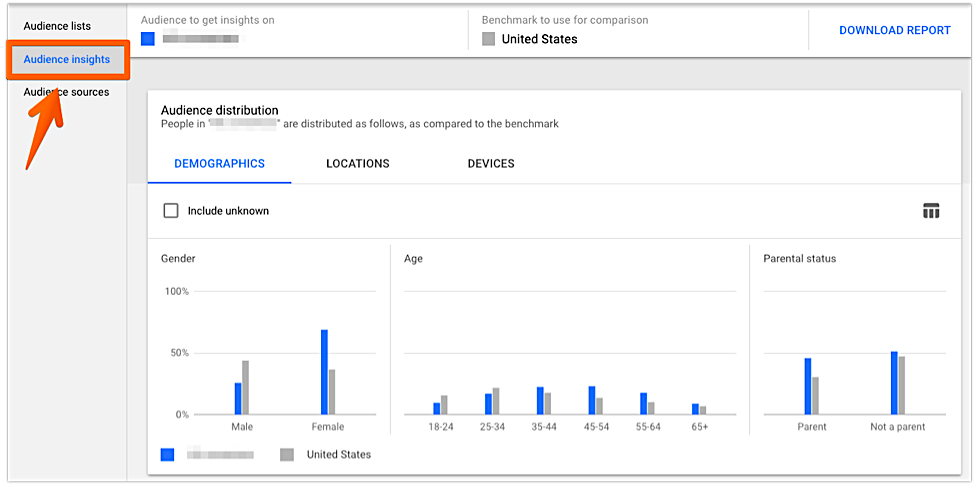
B) Re-capture non-converting search visitors. About 80% of the time, it takes 5 or more “touches” or brand impressions before someone will make a purchase. Remarketing makes getting in front of your prospects multiple times super simple and cost-effective, allowing you to extract the most value from each organic search visitor – especially the majority who don’t convert right away.
Remarketing also improves brand recall, making it more likely that these people will search for your brand name later and return to your site via organic search. And by staying on your audience’s mind, they may be more likely to trust and share your content, which can lead to more backlinks.
2) Search Terms Report
In AdWords, keywords are the phrases you’re targeting, while search terms are the phrases that people are actually typing into Google.
So you may be targeting the keyword “women’s running shoes,” but people are actually searching for things like “Nike women’s running shoes” or “women’s running shoes for marathons”.
The Search Terms report in AdWords will show you the exact phrases that are triggering your ads so you can target them with SEO. To see it, head into the Keywords section of your AdWords account and click the “Search Terms” tab at the top.
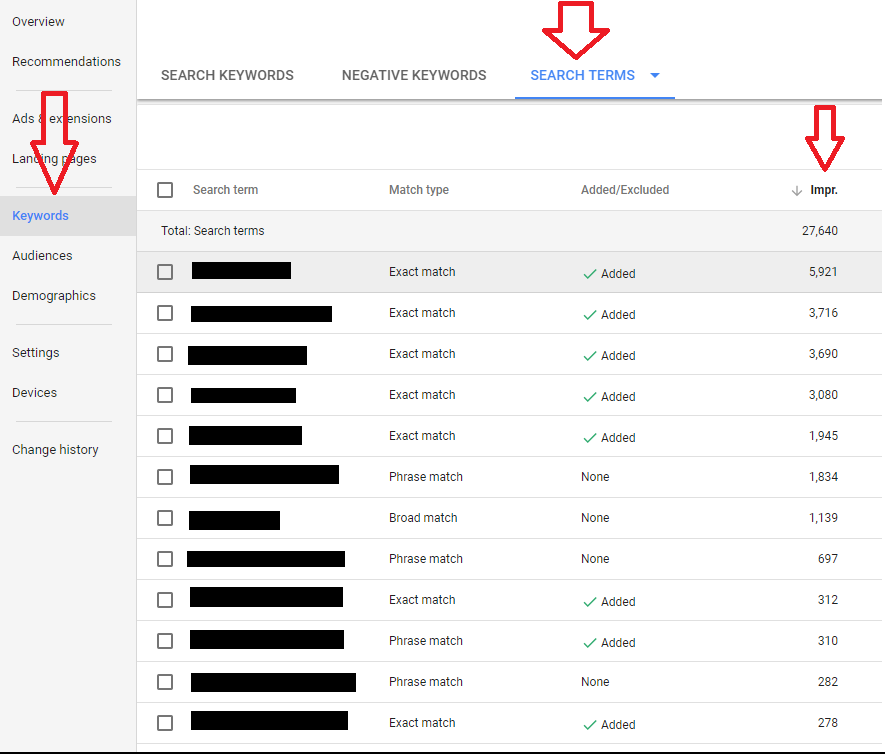
Do certain words or phrases get a ton of impressions? Which terms are bringing people to your site and leading to conversions?
Understanding (and targeting) these trends will give you a better understanding of how searchers – and Google – respond to your PPC campaigns.
Just remember that a successful SEO strategy targets keywords based not only on search volume, but on user intention. Short, competitive keywords like “shoes” could see millions of ad impressions, but it’s not worth putting your main focus on targeting them organically if the people making those searches aren’t clicking through to your site and converting into leads or purchases (not to mention the difficulty of ranking well for hyper-competitive keywords).
3) Ad Click-Through Rates (CTRs)
The percentage of people who’ve actually clicked on a given ad is its click-through rate, and it is a great metric to look at. Generally, a high CTR indicates a well-written ad – lots of people who’ve seen it have been convinced to engage and respond.
Translating your high CTRs from your AdWords account to your organic search snippets can pay massive dividends because an increase in your organic search CTR will not only directly bring in more traffic from your existing rankings, but it can also help to improve your rankings, creating a flywheel effect where you get even more traffic. That’s because CTR is one of the main factors that Google’s “RankBrain” machine-learning algorithm looks at to determine whether your site deserves better rankings.
But be careful not to optimize CTR at the expense of bounce rate and dwell time, both of which are also RankBrain factors. In other words, don’t over-promise and under-deliver.
I spoke with Stacy Caprio, founder of Accelerated Growth Marketing, who seconds the use of PPC data for finding the best headlines and keywords to use for your titles and content marketing campaigns. She says:
“The key is to always have 2+ ads running in each ad group so you can run split tests to find the headline winners. Then you can use this data to figure out what types of benefits and wording your audience responds to which you can work into the organic page wording and headlines.”
Dive into your AdWords account and see if you can find any patterns, trends or common denominators of high-CTR ads and keywords. And if you can’t find any actionable insights right off the bat, do some testing to get some.
Further Reading:
- How to Run an Effective Google AdWords Campaign
- How to Set Up Inbound Call Tracking in Google AdWords
- How to Set Up Google AdWords Ads in Google Maps
- The 6 Big Future Trends in PPC Advertising
Each part of your ads corresponds to a different part of your on-page SEO:
AdWords Ad Headlines ➡ Title Tags
Which headline formula drives more clicks through your PPC campaigns? Do your headlines that call out “free shipping” perform better or worse than those that say “free returns”?
Once you’ve discovered patterns like these, replicate them in the meta title tags of your website to increase their organic search CTR.
Going back to the example of “free shipping” vs. “free returns”, your new title tag for a product category page might look something like this: “Women’s Running Shoes | Free Shipping | Store Name”
AdWords Ad Descriptions ➡ Meta Descriptions
Again, look back through your AdWords data and analyze which ad descriptions are generating the highest CTRs.
Which selling points are connecting with people? Are they responding more to short, snappy sentences or longer, complex ones?
Whatever patterns you find, replicate them in your meta descriptions.
AdWords Keywords ➡ On-Page Content (and SEO Keywords)
The impressions, CTRs, and conversion rates of your keywords will help you identify which phrases are used most often by your target audience and which are the most valuable.
If you don’t have much budget to drive enough traffic to test conversion rates, you can also look at the CPC of each keyword to help distinguish between high and low commercial intent keywords.
As Alex Birkett, Growth Marketing Manager at HubSpot, told me:
“I like to look at the estimated CPC data to estimate the ’temperature’ of a given keyword, or how valuable it is, at least from a market-driven standpoint. If CPC is high, we can reason it’s valuable, and it’s probably valuable because of the high purchase or conversion intent of a visitor (not always the case, but a reasonable heuristic).
This allows me to bucket keywords into different user journey states, such as awareness, consideration, and decision. From a content creation and optimization perspective, this makes it easier to split content creation tasks among content and acquisition teams, but more importantly, it helps me choose the conversion path and offer on a given page.”
This knowledge will then allow you to create content that serves to both educate your visitors and nurture them toward a conversion.
So, once you’ve found some promising keywords, you could target them organically by:
- Creating long-form blog content around low commercial intent keywords to educate, acquaint, and nurture potential customers with your brand.
- Using conversion-optimized landing pages to target keywords with high commercial intent – i.e. the people who are ready to buy now.
4) Geographic Performance
SEO can be divided into many categories. One of those is local SEO – targeting people near any brick-and-mortar locations you may have.
After all, 60% of Americans use smartphones and tablets to find local services and information – and 18% of all local SEO searches lead to a sale on the same day.
Even if you don’t have any physical locations to use with local SEO, you can still use your geographic data from AdWords to enhance a regional, nationwide, or international SEO campaign.
First, here’s how to find your geographic performance in AdWords:
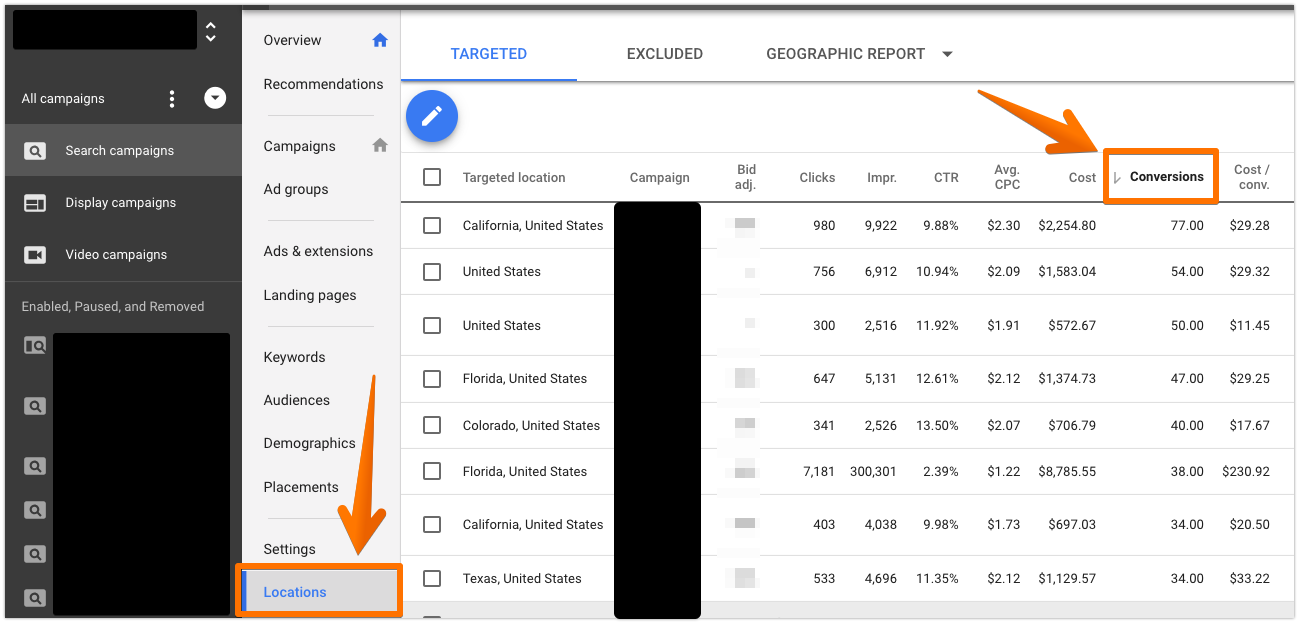
For each location – whether by city, state, region or country – you’ll want to look at:
- Conversions (or revenue): Which areas drive the most signups or sales?
- Clicks, Impressions and CTR: Is one geographical area more prone to clicking your ads?
Then, use Google Trends to see which types of phrasing people are using about your product or industry in those locations, and whether those phrases are growing or shrinking in popularity. Use that information to improve your on-page SEO and refine your keyword targets.
5) Display Network Audience Data
Although there is no official list of Google ranking factors, one thing is known for sure: backlinks are a strong off-site factor.
After analyzing a million search engine results, Backlinko found that URLs taking the top spots on page one have, on average, over 200 referring domains pointing backlinks at them. Just take a look at this chart from the study:

But building that many links to each page you want to rank can be a challenge, to say the least. That’s where Google Display Network data comes in. If you’re running display ads, you can use that data to find excellent link-building opportunities to improve your rankings.
To do this, go to the Placements report in a display campaign, then click the “Where Ads Showed” tab at the top. This will show you a list of sites your ads have been displayed on, along with the performance of each.
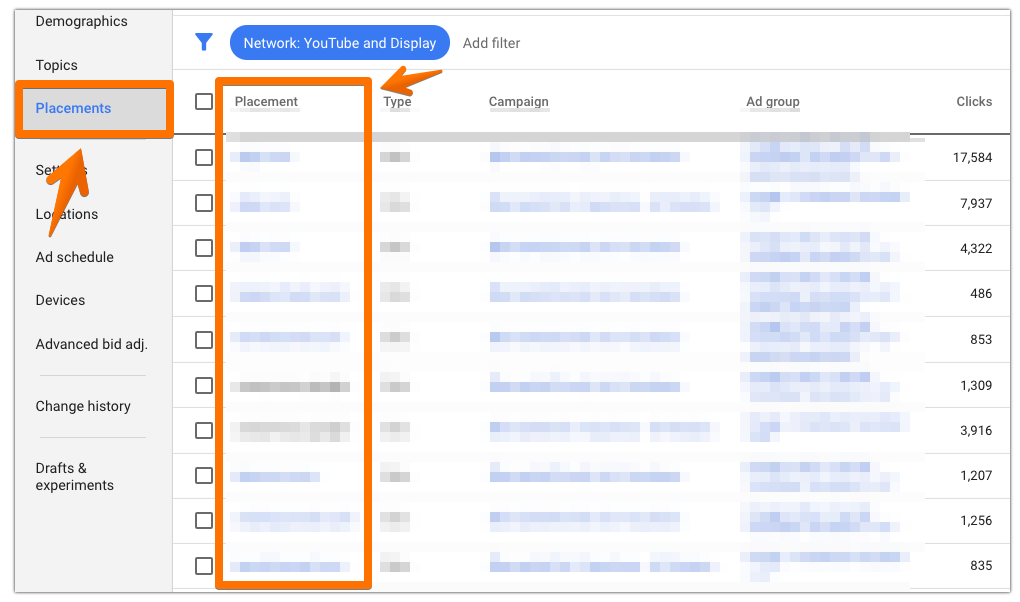
Sort by clicks or conversions, and consider what you see. For each entry that looks promising:
- Click through to the site and ask yourself, “Does this site have an engaged audience that could potentially be interested in my business?”
- Use a tool like Ahrefs or Moz to find out the site’s domain authority – i.e. a rough idea of how valuable a link from that site would be.
For those that look good, reach out to try to get a backlink from that site, via guest posting or any other link-building method of your choice.
This process is an easy way to find relevant sites to build links from, and will help you get the most out of your PPC campaign data.
Further Reading:
- How to Improve Your Amazon Ads to Increase Sales
- How to Implement a Cost-Effective SEO Strategy in 4 Steps
- 6 SEO Tactics for Maximum Customer Acquisition
- Do Twitter Ads Really Work? (Or Should You Focus on Other Platforms?)
6) Make It Easier to Pitch SEO
SEO is a long game. It can pay off tremendously over time, but it’s hard to get fast results.
Because it takes so long to get traction, it can be difficult to convince skeptical business owners (and even some marketing directors) of its value. If you’re struggling to project the value of a new SEO campaign – or justify the cost of the work you’re doing – AdWords gives you a quick answer to point to.
If the business is already spending $20,000 per month on PPC ads, that’s money that could potentially be saved in the future once your SEO results come into full swing. Or better yet, base your projections on the value that’s being driven by AdWords in terms of revenue.
However, breaking down the total costs or results of existing AdWords campaigns will highlight priorities to focus on, and help to augment those results with organic search.
Building an Ongoing SEO Strategy
Once you’ve analyzed your previous PPC campaigns and identified trends that you can replicate in organic SEO strategies, you’re onto a winner!
However, remember that SEO is a long-term game, so you’ll need to put time and effort into beating your competition. But that’s just another benefit of using AdWords to reinforce your efforts: you’re able to get plenty of traffic in the meantime, driving conversions and sales even as you focus on learning what works and what doesn’t.





